| View previous topic :: View next topic |
| Author |
Message |
Peter Megaw
Site Admin

Joined: 13 Jan 2007
Posts: 973
Location: Tucson, Arizona



|
 Posted: Sep 02, 2011 13:24 Post subject: Re: Mineral specimens with inclusions Posted: Sep 02, 2011 13:24 Post subject: Re: Mineral specimens with inclusions |
|
|
Miissed one
| Description: |
"psilomelane" in quartz
Level 3, Inglaterra Mine, Santa Eulalia, Chihuahua, Mexico
minature
"Psilomelane" (exact species unknown) and rhodochrosite (in background) in limpid quartz |
|
| Viewed: |
102319 Time(s) |
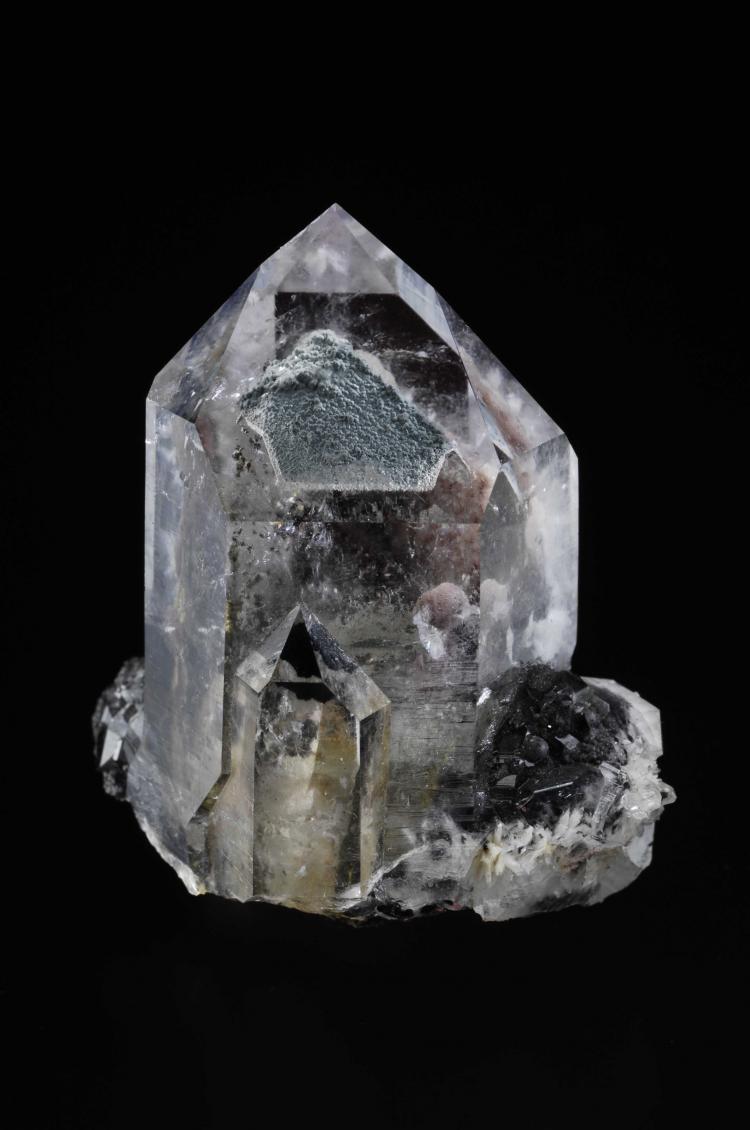
|
_________________
Siempre Adelante! |
|
| Back to top |
|
 |
Peter Megaw
Site Admin

Joined: 13 Jan 2007
Posts: 973
Location: Tucson, Arizona



|
 Posted: Sep 02, 2011 13:26 Post subject: Re: Mineral specimens with inclusions Posted: Sep 02, 2011 13:26 Post subject: Re: Mineral specimens with inclusions |
|
|
Should have also mentioned John Koivula's exhaustive work on inclusions in quartz...this is a wonderfully and profusely illustrated book
_________________
Siempre Adelante! |
|
| Back to top |
|
 |
John S. White
Site Admin

Joined: 04 Sep 2006
Posts: 1298
Location: Stewartstown, Pennsylvania, USA



|
 Posted: Sep 02, 2011 13:44 Post subject: Re: Mineral specimens with inclusions Posted: Sep 02, 2011 13:44 Post subject: Re: Mineral specimens with inclusions |
|
|
Elise, the apatite is seen through the quartz, it was not broken to expose the crystals.
Here is another favorite of mine. The black dot is a spherical bubble that is coated by some form of carbon. It moves back and forth about 5 millimeters, and is only about 2 mm in diameter. The quartz crystal is 4.8 cm across.
The locality given to me by the dealer is Zhao Tong, Yunan, China.
| Description: |
|
| Viewed: |
102225 Time(s) |
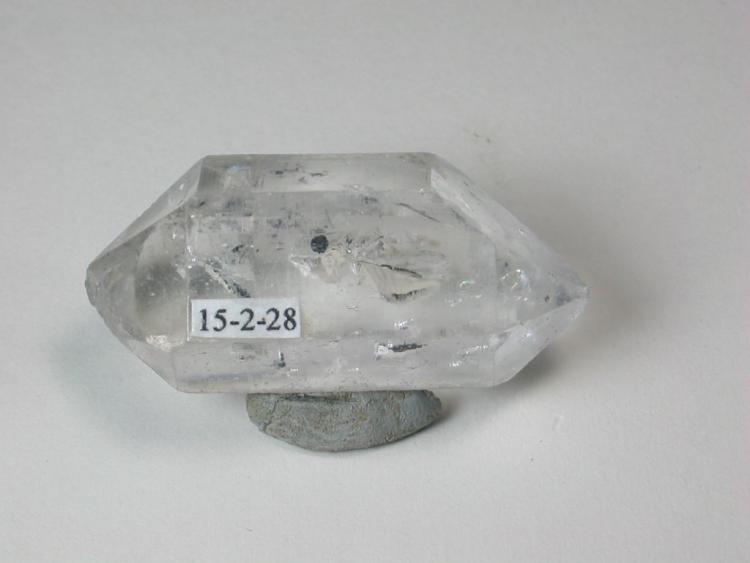
|
_________________
John S. White
aka Rondinaire |
|
| Back to top |
|
 |
Elise

Joined: 22 Dec 2009
Posts: 243
Location: New York State



|
 Posted: Sep 02, 2011 13:53 Post subject: Re: Mineral specimens with inclusions Posted: Sep 02, 2011 13:53 Post subject: Re: Mineral specimens with inclusions |
|
|
| Peter Megaw wrote: | (snip) There are actually several historic threads on FMF that deal with certain specific included materials... I am really glad you are tapping into this lode...
.....Should have also mentioned John Koivula's exhaustive work on inclusions in quartz...this is a wonderfully and profusely illustrated book |
Perhaps it would be nice to collect some links to those separate FMF threads within this current thread. This might make it a very useful and interesting resource. As some probably know, I am a great fan of John Koivula's work. One of my best memories is of sitting in the Koivula's livingroom while John gave me a tour of some of his favorite specimens - the dialogue was as much fun as getting to see the actual pieces. John White put a notice about the PhotoAtlas series here on FMF: https://www.mineral-forum.com/message-board/viewtopic.php?t=1112 I would think that these books would be of great interest to the mineral world; they certainly have been a very valuable asset to my collaboration with mineralogists. They just don't seem to be well known outside of the gem world, at least in academic circles.
_________________
Elise Skalwold |
|
| Back to top |
|
 |
Elise

Joined: 22 Dec 2009
Posts: 243
Location: New York State



|
 Posted: Sep 02, 2011 15:09 Post subject: Re: Mineral specimens with inclusions Posted: Sep 02, 2011 15:09 Post subject: Re: Mineral specimens with inclusions |
|
|
| xenolithos wrote: | | OK Elise - If I have got it right some of the 'blooms' are inside the quartz, not just on the surface. That is not the same as the cabochons I have seen cut from haematite-coated crystals, that have the red/brown patches on the outside. Thanks for the clarification. Duncan |
Hi Duncan - after staring at the photograph and thinking about what you described, you were right all along; the ovals were an artifact of the fashioning. It was only one phantom layer; in my haste to get a look at all the specimens in the box, I just did not see where the outline of the ovals broke the surface (on the more intriguing smaller cab) and had thought that their shape was natural ( the ovals themselves are made up of little formations which appear similar to those seen in John Koivula's PhotoAtlas Vol 2, page 609). In the photograph, the cab on the right shows the lower ovals as parallel to the prism face, not the rhombehedal face and not stacked as I had drawn it - it is confusing to sort out when looking through the cab, I had thought that the lower ones were below the 6 upper ones. I wish I had had it longer to study more carefully and not in the wee hours of the night. On the other cab I had noted the inclusions breaking the surface in some places, but had not thought about what it meant nor had I seen if the interface outlined the whole oval. My favorite quote via Dr. Roedder is appropriate at this juncture ... it has been pinned right next to my microscope for several years...maybe I should be made to sing it at the next FMF party...:
"A quotation from a 1743 book by Henry Baker, "The Microscope Made Easy, " provides a fitting admonition for all inclusionists involved in the many problems of phase (and artifact) identification in fluid inclusions (Dr. Edwin Roedder, 1992): "Beware of determining and declaring your Opinion suddenly on any Object; for Imagination often gets the Start of Judgement, and makes People believe they see Things, which better Observations will convince them could not possibly be seen: therefore assert nothing till after repeated Experiments and Examinations in all Lights and in all Positions. When you employ the Microscope, shake off all Prejudice, nor harbour any favorite Opinion; for, if you do, 'tis not unlikely Fancy will betray you into Error, and make you think you see what you would wish to see. Remember that Truth alone is the Matter you are in search after; and if you have been mistaken, let not Vanity seduce you to persist in your Mistake."
_________________
Elise Skalwold |
|
| Back to top |
|
 |
Antonio Alcaide
Site Admin

Joined: 23 Aug 2009
Posts: 314
Location: Spain



|
|
| Back to top |
|
 |
Antonio Alcaide
Site Admin

Joined: 23 Aug 2009
Posts: 314
Location: Spain



|
|
| Back to top |
|
 |
am mizunaka

Joined: 09 Apr 2010
Posts: 2184
Location: USA



|
 Posted: Sep 02, 2011 19:43 Post subject: Re: Mineral specimens with inclusions Posted: Sep 02, 2011 19:43 Post subject: Re: Mineral specimens with inclusions |
|
|
Quartz with rutile inclusions.
| Description: |
Quartz
Dalbandin, Balochistan, Pakistan
7.5 x 5 cm. |
|
| Viewed: |
42228 Time(s) |
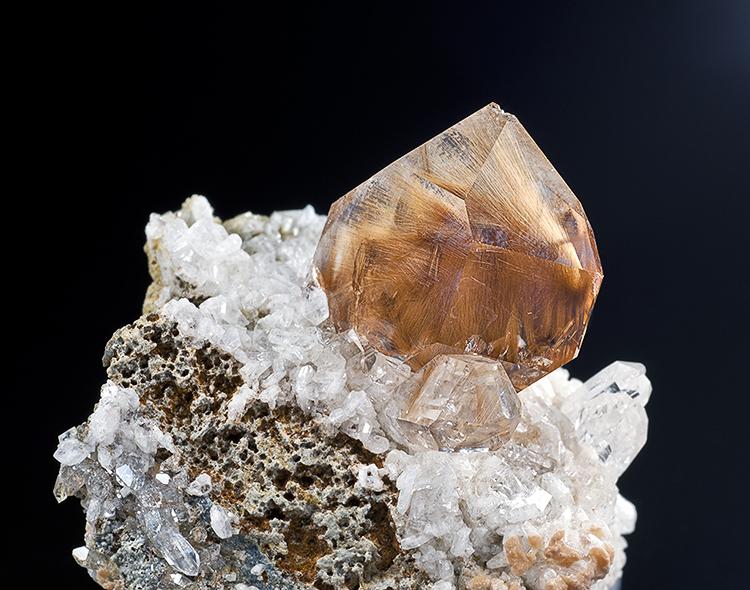
|
|
|
| Back to top |
|
 |
vic rzonca

Joined: 18 Nov 2008
Posts: 820
Location: MA



|
 Posted: Sep 02, 2011 19:45 Post subject: Re: Mineral specimens with inclusions Posted: Sep 02, 2011 19:45 Post subject: Re: Mineral specimens with inclusions |
|
|
| On re-reading my entry, it seems a little pedestrian to ask, is an inclusion confined to the inbound side of the of the included matrix? And do inclusions manifest themselves on the surface, where they might become a specimen on matrix? I just dropped in, pardon me.
|
|
| Back to top |
|
 |
Elise

Joined: 22 Dec 2009
Posts: 243
Location: New York State



|
 Posted: Sep 02, 2011 20:37 Post subject: Re: Mineral specimens with inclusions Posted: Sep 02, 2011 20:37 Post subject: Re: Mineral specimens with inclusions |
|
|
| vic rzonca wrote: | | On re-reading my entry, it seems a little pedestrian to ask, is an inclusion confined to the inbound side of the of the included matrix? And do inclusions manifest themselves on the surface, where they might become a specimen on matrix? I just dropped in, pardon me. |
This is one of my own favorite pieces - the included crystals break the surface and some form nice "specimens on matrix"- only appreciated under the microscope. The quartz crystal cluster below has blue tourmaline throughout, along with other inclusions I haven't identified. I am basing the tourmaline ID on that the crystals are strongly pleochroic (very dark blue and pale blue perpendicular to the long axis), striations along their length and the distinctive tourmaline cross-section seen as they break the surface of the quartz. They give the quartz a beautiful blue color, though in the top photo, while trying to get the sprays at the base of the quartz to show, they are blown-out. The blue is seen better in the crystal fragment in the next photo, oriented so two prism faces show. A tourmaline crystal is shown on the microscope monitor popping up through a cluster of unknown crystals embedded in the quartz face -- there are others coming through elsewhere sans yellowish crystals, but they don't show the form as nicely as this little one.
There is an interesting recently released paper on blue quartz for those who would like to know more about blue quartz colored by inclusions: Distinctive properties of rock-forming blue quartz: inferences from a multi-analytical study of submicron mineral inclusions.W. Seifert, D. Rhede, R. Thomas, H.-J. Förster, F. Lucassen, P. Dulski and R. Wirth. Mineralogical Magazine,2011, Volume 75, Number 3
Cheers!
Elise
| Description: |
Blue Quartz (quartz included with blue tourmaline)
unknown
35mm wide x 40 mm high |
|
| Viewed: |
42155 Time(s) |
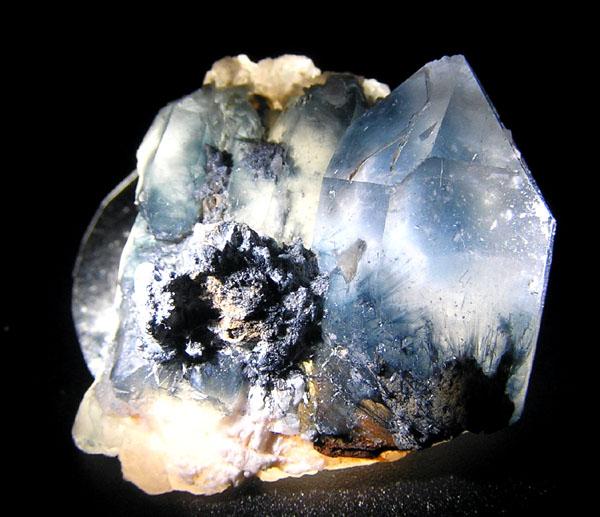
|
| Description: |
Quartz (included with blue tourmaline), crystal fragment showing prism face junction
unknown
30mm wide x 25mm high |
|
| Viewed: |
42219 Time(s) |
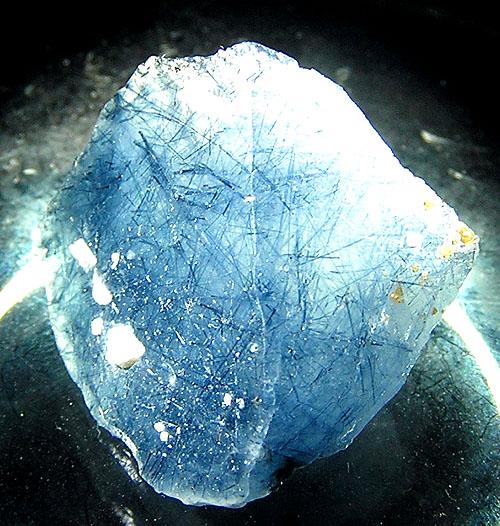
|
| Description: |
tourmaline on quartz and unknown xtls (detail of crystal fragment in above photo).
unknown
approx. 1.0 mm |
|
| Viewed: |
42188 Time(s) |
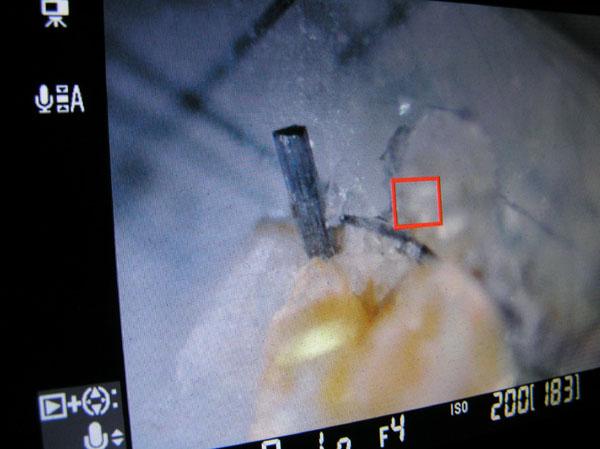
|
_________________
Elise Skalwold |
|
| Back to top |
|
 |
Duncan Miller

Joined: 25 Apr 2009
Posts: 138
Location: South Africa



|
 Posted: Sep 03, 2011 02:00 Post subject: Re: Mineral specimens with inclusions Posted: Sep 03, 2011 02:00 Post subject: Re: Mineral specimens with inclusions |
|
|
Elise
You are scholarly, gracious, good humoured, and you write extremely well. I think there is great merit in your introducing some gemmology to this forum, Jordi's prejudice against crystal choppers notwithstanding! After all, the internal world of gemstones is also the internal world of minerals, and a crystal doesn't have to have faces to be crystalline.
I have arranged for the cutter of one of the Orange river quartz cabochons with haematite spots to bring it to our gem and mineral club meeting today, where I will photograph it and send you the photo privately, as we are now agreed the spots are artefacts, and so off topic.
Duncan
|
|
| Back to top |
|
 |
Duncan Miller

Joined: 25 Apr 2009
Posts: 138
Location: South Africa



|
 Posted: Sep 03, 2011 02:15 Post subject: Re: Mineral specimens with inclusions Posted: Sep 03, 2011 02:15 Post subject: Re: Mineral specimens with inclusions |
|
|
This is an edited re-post of a specimen in Peter Megaw's 'sand crystal' thread.
This smoky quartz with aegerine is from Malosa, Malawi. The aegerine crystals penetrate and poke out of all sides of the quartz crystal. Most of them are terminated, some of them doubly where they penetrate right through the quartz crystal. So, how did this grow? Did the aegerine nucleate before the quartz, which then partially engulfed it?
Duncan
| Description: |
Aegerine and quartz
Malosa, Malawi
70 mm long |
|
| Viewed: |
42090 Time(s) |
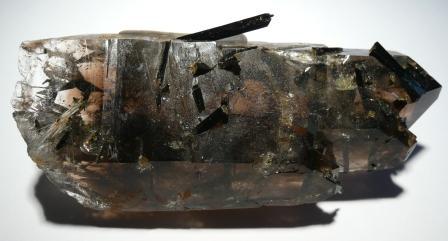
|
|
|
| Back to top |
|
 |
John S. White
Site Admin

Joined: 04 Sep 2006
Posts: 1298
Location: Stewartstown, Pennsylvania, USA



|
 Posted: Sep 03, 2011 05:29 Post subject: Re: Mineral specimens with inclusions Posted: Sep 03, 2011 05:29 Post subject: Re: Mineral specimens with inclusions |
|
|
Another one, this one a bit different. This is a chlorite-included quartz from the Tipling mine, Dhading district, Nepal, in which inclusion-free quartz grew over the termination creating a scepter. The piece is 8.5 cm tall.
| Description: |
|
| Viewed: |
42142 Time(s) |
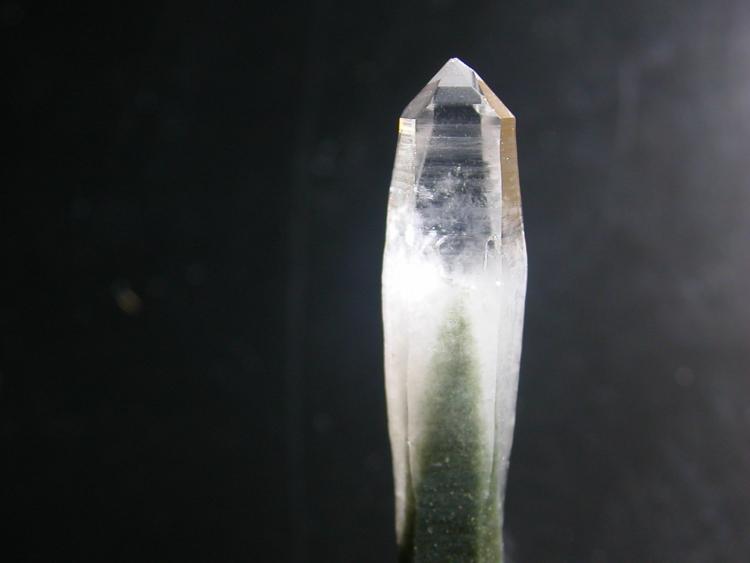
|
| Description: |
|
| Viewed: |
42097 Time(s) |
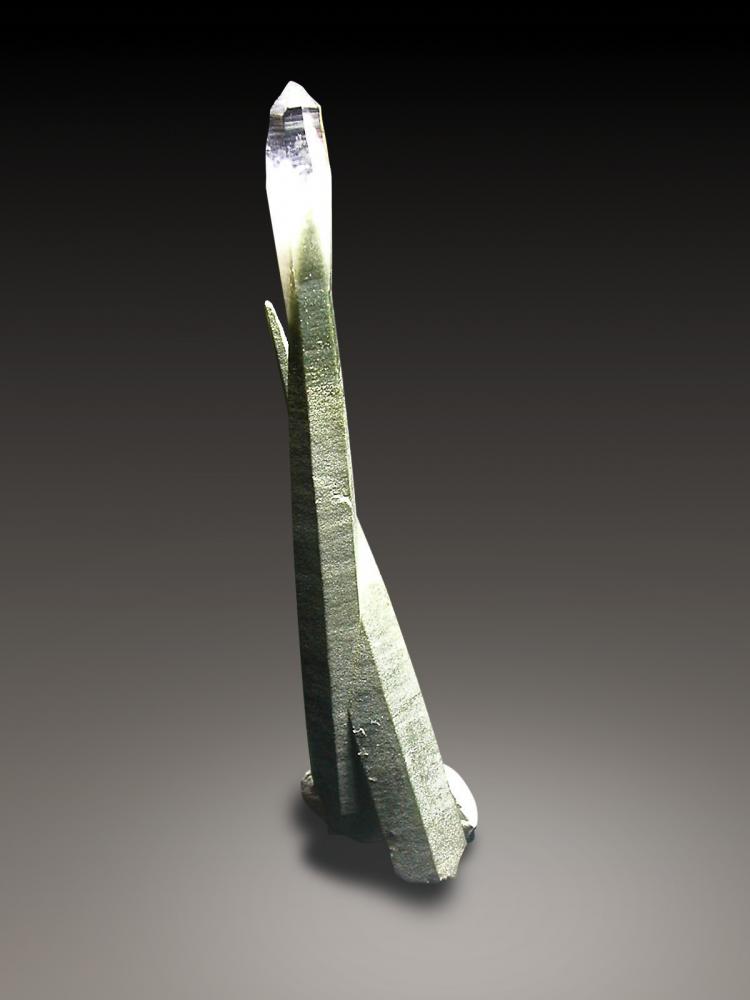
|
_________________
John S. White
aka Rondinaire |
|
| Back to top |
|
 |
John S. White
Site Admin

Joined: 04 Sep 2006
Posts: 1298
Location: Stewartstown, Pennsylvania, USA



|
 Posted: Sep 03, 2011 05:37 Post subject: Re: Mineral specimens with inclusions Posted: Sep 03, 2011 05:37 Post subject: Re: Mineral specimens with inclusions |
|
|
The inclusions in quartz from Pakistan described as rutile by am mizunaka look to me very much like astrophyllite, which appears to be relatively common in quartzes from Zagi Mountain in the Northwest Frontier Province.
_________________
John S. White
aka Rondinaire |
|
| Back to top |
|
 |
al mar
Joined: 17 Feb 2009
Posts: 21
Location: Biscay, Spain



|
 Posted: Sep 03, 2011 05:45 Post subject: Re: Mineral specimens with inclusions Posted: Sep 03, 2011 05:45 Post subject: Re: Mineral specimens with inclusions |
|
|
| Elise, I have seen some very similar blue quartz specimens from Brazil .
|
|
| Back to top |
|
 |
|





